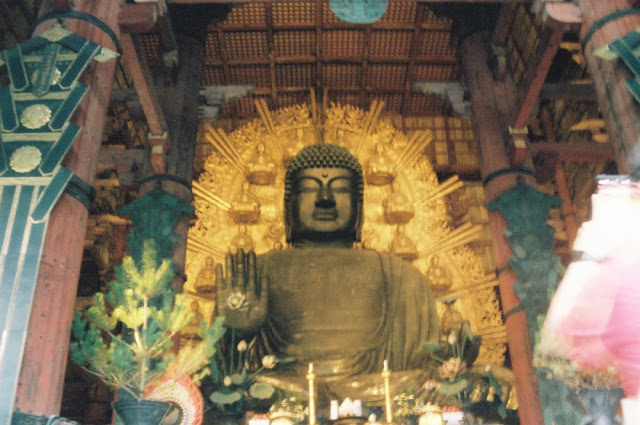Sunday, October 27, 2024
Goldstein quote
Monday, October 21, 2024
Images, memes, quotes, art, photos
Previous one and before that.
From Japan
Friday, October 11, 2024
Goldstein quote
P68-69 The Experience of Insight by Joseph Goldstein
kukkucca, uddacca
“The fourth of the hindrances the Buddha mentions in the Satipatthana Sutta are the mind states of restlessness and worry. The Pali word for restlessness is uddacca, which means agitation, excitement, or distraction. It is sometimes translated as "shaking above," where the mind is not settled into the object but hovering around it. "Restlessness" —literally, without rest—expresses all these aspects. The Pali word for worry is kukkucca, which is the mind state of regret or anxiety. This refers to how we feel about not having done things that we should have done and about having done things that we shouldn't have. Although restlessness almost always accompanies worry, it is possible to have restlessness present without worry or regret.”
P153 Mindfulness by Joseph Goldstein.
Tuesday, October 08, 2024
Meditation support
Saturday, October 05, 2024
The Five Aggregates
The Five Aggregates by Mathieu Boisvert, teaches at University of Quebec in Montreal, starts like this with a forward by A.K. Warder:
In Buddhist philosophy, the theory of the five aggregates (pancakkhandha) of realities, or real occurrences known as "principles" (dhamma), is the analysis of what elsewhere is often called the "problem" of matter and mind. In Buddhism, to separate these would be to produce a dilemma like the familiar one of "body" and "soul" (are they the same or different?). But the resolution is different. Whereas the "soul," according to Buddhism, is a non-entity and the problem therefore meaningless, consciousness is as real as matter. The tradition emphasizes that consciousness is inseparably linked to matter: there can be no consciousness without a body; although there ·could be a body without consciousness, it would not be sentient.
Matter and consciousness are two of the "aggregates"; the other three link them, or rather show diem.·inseparably bound together in a living being. These are, to use Boisvert's translations, "sensation" (vedana, variously translated as "experience," "feeling," etc.), "recognition" (sanna or "perception") and "karmic activities" (sankhara, "forces," "volition," etc.). Sensation - being either pleasant, unpleasant or neutral - can occur only in a body which is conscious. Similarly, recognition occurs solely when consciousness is aware of sensations. The karmic activities, sometimes restricted to volition (cetana), were gradually elaborated to include about fifty principles, from "contact" (phassa, the combination of a sense organ, its object and consciousness), energy and greed.: to understanding, benevolence, compassion and attention.
Links:
Review of The Five Aggregates
We are all subject to death, we lost K today.
Friday, October 04, 2024
Friend wanted a list of Sangharakshita talks
First one is actually Christopher Titmus, What self, what world (2005), warm up.
Sangharakshita:
First talk I think about is Mind Creative, Mind Reactive (1967).
The Ten Pillars of Buddhism (1984)
Here are 8 talks on the Bodhisattva Ideal (1999).
History of Going For Refuge (1988)
Here's an example of the Sevenfold Puja ritual (1968)
6 talks on Milarepa (2006)
Wisdom Beyond Words (8) (1993)
What is the Dharma (7) (2000)
The Path of Regular Steps and the Path of Irregular Steps (1974)
Evolution: Lower and Higher (1966)
Wednesday, October 02, 2024
Rosh Hashanah
Rosh Hashanah begins ten days of penitence culminating in Yom Kippur, as well as beginning the cycle of autumnal religious festivals running through Sukkot which end on Shemini Atzeret in Israel and Simchat Torah everywhere else. (Wikipedia)
They're selling flowers on a Wednesday:
Eating symbolic foods, such as apples dipped in honey, hoping to evoke a sweet new year, is an ancient tradition recorded in the Talmud.
Three books of account are opened on Rosh Hashanah, wherein the fate of the wicked, the righteous, and those of the intermediate class are recorded. The names of the righteous are immediately inscribed in the Book of Life and they are sealed "to live". The intermediate class is allowed a respite of ten days, until Yom Kippur, to reflect, repent, and become righteous; the wicked are "blotted out of the book of the living forever."
The best-known ritual of Rosh Hashanah is the blowing of the shofar, a musical instrument made from an animal horn.
This is when I see the fellows down by the water praying: The ritual of tashlikh is performed on the afternoon of the first day of Rosh Hashanah by most Ashkenazic and Sephardic Jews (but not by Spanish and Portuguese Jews or some Yemenites, as well as those who follow the practices of the Vilna Gaon). Prayers are recited near natural flowing water, and one's sins are symbolically cast into the water. Many also have the custom to throw bread or pebbles into the water, to symbolize the "casting off" of sins.
The Hebrew common greeting on Rosh Hashanah is Shanah Tovah.
Tuesday, October 01, 2024
Disappearance of consciousness
So thinking a lot about what you do when you get big sky mind? You just keep going is the answer.
What's after that? What do you try for there? You're going into deeper meditative states.
Reading today in Satipatthana sutta the phrase, "disappearance of consciousness."
With deep meditative states that's maybe a description of absorption and you just build a reservoir of deep and wide meditative experiences.




































